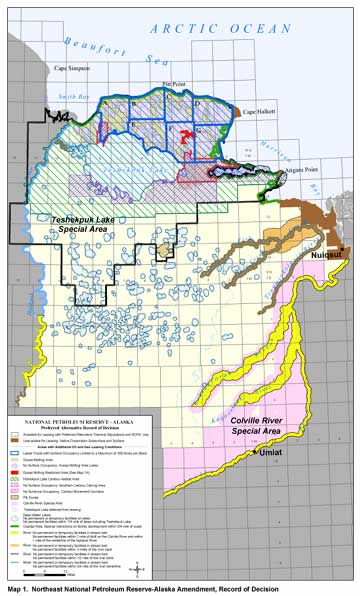 By M.C. Kauffman January 12, 2006
The amendment to the Northeast National Petroleum Reserve-Alaska 1998 plan was approved Wednesday by Deputy Assistant Secretary of the Interior, Chad Calvert, paving the way for drilling in an area that previously had been off limits because of concerns about the impact on wildlife. The approval came just three weeks after Congress blocked energy development in the nearby Arctic National Wildlife Refuge.
"I am very pleased with today's Interior Department decision," said Governor Murkowski. "It is consistent with my administration's recommendations, and reinforces the fact that Alaska's abundant energy resources are absolutely critical to meeting our nation's energy needs." The Northeast National Petroleum Reserve-Alaska may contain as much as two billion barrels of economically recoverable oil according to the Bureau of Land Management officials. This decision also opens the way for an additional oil and gas lease sale, probably in the fall of 2006. The Interior Department gave final approval to develop the Teshekpuk Lake region, setting up an oil-lease sale in September. The decision came a year after the Bureau of Land Management recommended drilling in the region, which lies west of the wildlife refuge on Alaska's North Slope. "Alaskans have proven that we can develop our tremendous oil and gas reserves in environmentally responsible ways while at the same time protecting subsistence resources," Governor Murkowski said. "Today's announcement from the Interior Department is very good news for our state." However, opponents say the
decision eliminates long-established wildlife and environmental
protections first put in place by Reagan Administration Interior
Secretary James Watt. Stan Senner, executive director of Audubon Alaska said, "This plan is utterly unbalanced: even the Reagan Administration protected the waterfowl habitat around Teshekpuk Lake because of its world-class ecological and cultural value." He said, "No one should be fooled by the window dressing in this document: this plan makes every last acre available for oil development. The administration has decided that there isn't one acre of this magnificent region that should be protected." Bureau of Land Management officials say the amendment will guide leasing, exploration and development in the Petroleum Reserve for the next 10 to 20 years using lease stipulations and required operating procedures similar to those adopted for the adjacent northwest area of the Petroleum Reserve in 2004. The Record of Decision, signed January 11, 2006 contains a number of changes to the Final Amended Integrated Activity Plan and Environmental Impact Statement released in January 2005. "As a result of comments from local government, North Slope residents, and various organizations, a number of modifications have been included specifically to benefit subsistence users and wildlife values in the northeast planning area," said Bureau of Land Management Alaska State Director Henri Bisson. "Also, the plan will allow us to refine and adapt our management as new research and new technologies emerge," said Bisson. Modifications as outlined by the Bureau of Land Management Alaska to the final amended IAP/EIS include:
"Subsistence activities in the planning area, particularly hunting and fishing are exceedingly important to local residents. We have listened to their concerns and added these additional provisions to the plan to assure that local traditions can continue," said Bisson. Other provisions of the plan, such as deferring leasing on Teshekpuk Lake remain unchanged. According to information provided
by the Wilderness Society, efforts to open the Teshekpuk Lake
area to drilling have consistently drawn fire from a variety
of groups, including the California Waterfowl Association, Ducks
Unlimited, the Pacific Flyway Council, Wildlife Management Institute,
The Wildlife Society, U.S. Fish & Wildlife Service, Environmental
Protection Agency, The Nature Conservancy and numerous conservation
groups. In addition, according to the Wilderness Society, 200
ornithologists and other wildlife professionals, and a bipartisan
group of the Congressional Sportsmen's Caucus called for Teshekpuk
Lake area protections to remain in place. On the Web:
Publish A Letter on SitNews Read Letters/Opinions Submit A Letter to the Editor
|
||
